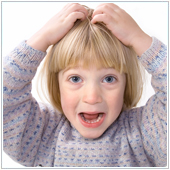 We’ve all heard of lice, your family has even probably had a scare or two. Of the three variations of lice – head lice, body lice and public lice – head lice is the most common. Furthermore, according to a WebMd article, surveys have shown that 10-20% of school children have head lice at any given time. The question is … are you and your family prepared for an outbreak?
We’ve all heard of lice, your family has even probably had a scare or two. Of the three variations of lice – head lice, body lice and public lice – head lice is the most common. Furthermore, according to a WebMd article, surveys have shown that 10-20% of school children have head lice at any given time. The question is … are you and your family prepared for an outbreak?
First, what is head lice?
Lice are tiny, wingless insects that live among human hairs and feed on extremely small amounts of blood drawn from the scalp. While gross, contagious and annoying, had lice is not known to spread diseases or be dangerous.
How do you prevent head lice?
The MayoClinic explains that the spreading of lice among school children can be difficult to prevent since it spreads through personal contact and sharing belongings. Contrary to popular belief, the spreading of lice has nothing to do with hygiene and can’t be prevented by improvements in that area. Some products claim to repel lice, but haven’t been tested or proven by the FDA. Your best bet is to talk with your child about a few measures they can take.
-
Limit sharing: ask your child not to share their belongings like hats, scarves, headphones or helmets
-
Keep it separate: if at all possible, use a separate locker to store belongings and hang coats in a different area than the rest of the class
-
Avoid contact: avoid head-to-head contact and never share a hairbrush
How do I know if I have head lice?
You or your child may have lice if the following signs and symptoms are experienced:
-
Itching and Scratching: it may take a few weeks for itching to begin, so other symptoms may appear first
-
Tickling: kids may experience the feeling of tickling or moving on their head
-
Visible eggs (nits) or lice on the scalp, clothing, or skin: nits may look like dandruff, while lice may look like a small sesame seed
-
A rash: small, red bumps on the scalp, neck, or shoulders may develop
Treating Head Lice
Luckily, treating all types of lice, especially head lice, is simple. Head lice can almost always be treated with an over-the-counter product, picked up from your local pharmacy. Special shampoos developed to combat lice are the first line of defense. It’s important to follow the directions closely and consult your pharmacist with any questions.
Once the lice has been removed from the hair and body, the next step is to make sure all nits are removed and that the home, clothing and personal items are not contaminated. Missing this step could result in the lice spreading to other family members or returning to the original carrier. Disinfect combs and brushes, hats, jackets, backpacks, bedding, and toys with hot, soapy water.
The prevention, identification, and treatment of this common parasite is important. No matter what issue your family is facing, your neighborhood health experts at [company_short] are here to help. Call [phone_main] to speak with a pharmacist anytime you need us.